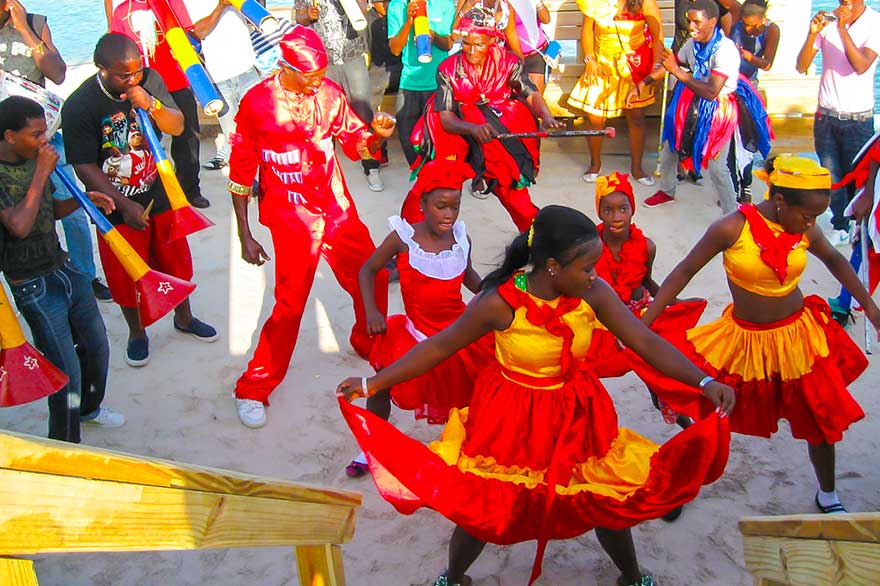
13 Oct What are the typical dances of the Dominican Republic?
What are the typical dances of the Dominican Republic?
The Dominican Republic is one of the most popular tourist destinations due to its infinite beaches with fine white sand. But this paradise not only has an exuberant landscape to offer. It is also rich in culture and traditions.
Learning about the typical dances and traditional music of the Dominican Republic is one of the greatest pleasures you can experience on your next holiday in Punta Cana. That’s why we’ve put together the definitive list of typical Dominican dances that you need to be familiar be with so that you can recognise them as soon as they start playing:
- Merengue
- Bachata
- Salsa
Below, we’ll talk about each folk dance so you can learn all about the origins of each style, their characteristics, type of rhythm and dance steps.
Merengue
Merengue is a musical genre born in the mid-nineteenth century in the Dominican Republic. It originated in the sugar beet fields and has managed to cross borders, becoming one of the most famous genres in the world.
In 2016, it was declared a Masterpiece of the Cultural, Oral and Intangible Heritage of Humanity by UNESCO.
In its origins, it was played with string instruments such as the guitar or the bandurria, but little by little the accordion, the tambora drum, the güira, the saxophone and sometimes keyboards or timpani were incorporated.
It is an easy and fun dance to learn, which makes it very popular. It has three basic steps or movements: a side step, one forward and one backward. When you learn these merengue steps and start combining them, that’s when you’ll be able to easily dance an entire merengue song.
You can learn more about the authentic Dominican merengue by clicking here.
Bachata
Bachata is a combination of merengue, son cubano and bolero. It emerged in the early 20th century in the most marginal neighbourhoods of the Dominican Republic, but soon it began to be heard in all kinds of parties and bars until it became one of the most popular dance genres, to the point of reaching the most sophisticated levels of the Dominican musical culture, being performed by celebrities such as Víctor Víctor or Juan Luis Guerra.
Its lyrics talk about heartbreak, melancholy and passion, something that translates into the steps and movements that make up this tremendously sensual dance, where couples dance close together in complete harmony.
There are four basic steps or movements of bachata: a lateral step, another lateral step to the opposite side, a movement of the right foot to the side and then the feet are brought back together, although the last foot to move is kept forward. The movement varies between the couple who is dancing together, so while one starts with the movement to the left, which is usually done by the man, the other half of the couple, generally the woman, moves to the right.
The dance continues with twists and swooping movements that will mesmerise you, but with practice you’ll be able to do it too.
Salsa and son
Although these dance genres didn’t necessarily originate in the Dominican Republic, both types of dances have managed to become extremely popular.
Salsa and son make up two types of danceable music genres from the Caribbean that have spread across the world, whose origins and authorship are debated among Cubans, Dominicans and Puerto Ricans.
Although they are sister melodies, they have some differences:
Son is a musical genre that was born in the Caribbean. However, it has been concentrated in Cuba, being the first genre to arrive in the country and from which the Cuban son was born.
Salsa, on the other hand, can be confused with Cuban son, since it is a musical genre resulting from the fusion of Caribbean music and Cuban son. In addition, the melodies used in salsa are the same as in son, with only some minor differences.
However, the most notable difference may be the instruments: the Cuban son uses subtle piano, cello, timpani, bongo, harpsichord, guitar and trumpet melodies; while salsa uses typical Cuban instruments from the 1920s such as timbales, maracas, the Cuban güiro, piano, double bass, trumpets, flutes and the violin.
Although both styles use different instruments, the melodies sound almost the same, so it is difficult to differentiate between the two types of dances.
Where to find live music
In the capital of the Dominican Republic, Santo Domingo, you’ll find some of the most famous nightclubs on the island and the best places to enjoy tropical rhythms, with live orchestras on Mondays.
In the Dominican capital there are also emblematic clubs for listening to live Latin music. Stars like Bonny Cepeda, Manny Manuel, Sergio Vargas and Ala Jaz have performed on their stages. Live music usually starts at 11 pm, but it’s a good idea to get there earlier to get a good spot.
If you stay in Punta Cana, you’ll also find numerous places where you can dance and listen to son, bachata and salsa. In addition, if you are a beginner and would like to learn Latin dances, you’ll be able to take different introductory classes.
Are you ready for a holiday set to the most Dominican rhythm? Let the music play!




No Comments